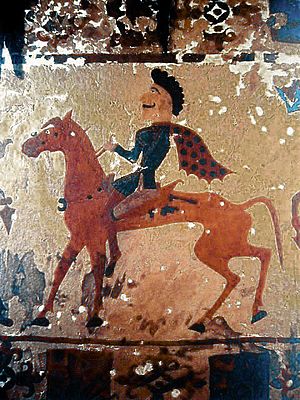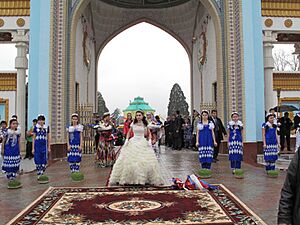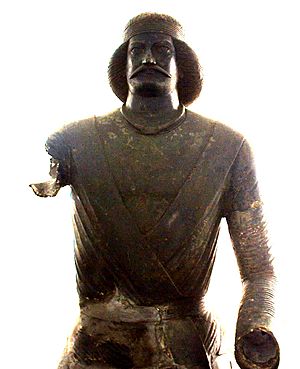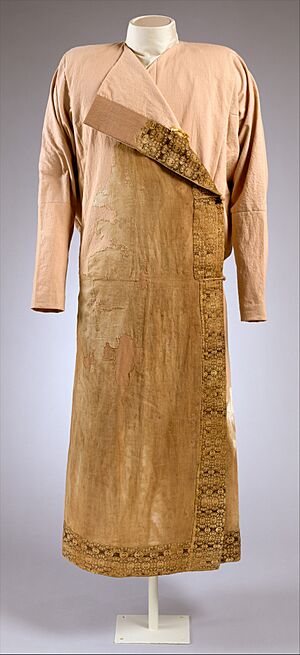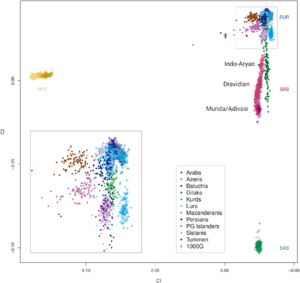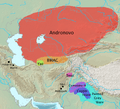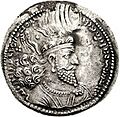Iranian peoples facts for kids
| Total population | |
|---|---|
| Over 170 million | |
| Regions with significant populations | |
| West Asia and parts of Turkey, Caucasus and Ossetia, Central Asia, western areas of South Asia, western areas of Xinjiang (China) (Historically also: Eastern Europe) |
|
| Languages | |
| Iranian languages (a branch of the Indo-European languages) | |
| Religion | |
| Predominately: Islam (Sunni and Shia) Minorities: Christianity (Eastern Orthodoxy, Nestorianism, Catholicism, and Protestantism), Judaism, Baháʼí Faith, Yazidism, Yarsanism, Zoroastrianism, Assianism (Historically also: Iranian paganism, Buddhism, and Manichaeism) |
The Iranian peoples are a group of people connected by their use of Iranian languages and similar cultures. These languages are part of the larger Indo-European languages family.
The first Iranian-speaking groups, called Proto-Iranians, likely appeared in Central Asia around 1500 BC. At their largest, around 500 BC, Iranian peoples lived across a huge area. This stretched from the Danube River in the west to the Ordos Plateau in China and the Iranian Plateau in the south.
Many ancient Iranian groups existed, including the Medes, Parthians, Persians, Sakas, Sarmatians, and Scythians. They lived in West Asia, Central Asia, Eastern Europe, and the Eurasian Steppe. Over time, their lands shrunk due to the expansion of other groups like Slavs, Germanic tribes, and Turkic peoples. Many Iranian groups became part of these new cultures.
Today, modern Iranian peoples include the Baloch, Kurds, Ossetians, Pashtuns, Persians, and Tajiks. They live mainly across the Iranian Plateau. This area goes from the Caucasus in the north to the Persian Gulf in the south. It also stretches from eastern Turkey in the west to western China in the east. This region is sometimes called the Iranian Cultural Continent.
Contents
What Does "Iranian" Mean?
The word Iran comes from the Middle Persian word Ērān. This word, and the older Old Persian ariya-, mean "Iranian." It was used to describe people who belonged to the same ethnic group.
The term arya- is found in ancient texts and inscriptions. For example, the Behistun Inscription from the 6th century BC mentions the Arya language. This inscription was made by Darius the Great, a Persian king. He also described himself as "an Aryan, of Aryan stock." This shows that the term arya- meant "Iranian" and referred to their shared heritage.
Even Greek writers like Herodotus noted this. He wrote that the Medes, an Iranian people, were called Arians by everyone. Later, Strabo wrote that people in Persia, Media, Bactria, and Sogdia spoke similar languages. He said they were all part of "Ariana."
So, the name Arya was a way for these groups to say they were one people. They shared a language and religious traditions.
It is important to know that "Iranian" as a cultural and linguistic term is different from the country of Iran. Just like "Germanic peoples" is different from "Germans". Not everyone living in Iran today speaks an Iranian language.
"Iranian" vs. "Iranic"
Some experts prefer to use "Iranic" when talking about the language family. This is because many of these languages are spoken outside of Iran. They use "Iranian" for things related to the country of Iran. This is similar to how we say "German" for the country and "Germanic" for the language group.
History of Iranian Peoples
Early Roots and Migrations
The ancestors of Iranian peoples are linked to the Indo-Iranians. These groups came from the Pontic steppes in Eastern Europe.
Proto-Indo-Iranians
The Proto-Indo-Iranians are often linked to the Sintashta culture and Andronovo culture. These cultures were found in the Eurasian steppe, near the Ural River.
Indo-Iranian groups moved in two main waves. The first wave included Indo-Aryans. They moved through Central Asia into places like the Levant (where they founded the Mittani kingdom) and northern India. The Indo-Aryans separated from the Iranians around 1800–1600 BC.
The second wave was the Iranian wave, starting around 800 BC.
Sintashta Culture
The Sintashta culture was a Bronze Age culture (2100–1800 BC) in the northern Eurasian steppe. It is believed to be where the Indo-Iranian languages developed.
This culture likely grew from earlier groups like the Poltavka and Abashevo cultures. The people of Sintashta were good at raising cattle. They also had strong connections to the Corded Ware culture.
The oldest known chariots were found in Sintashta burials. This suggests that this culture might be where chariot technology began. Chariots were very important in ancient wars. Sintashta settlements also had a lot of copper mining and bronze making.
Andronovo Culture
The Andronovo culture was a group of similar Bronze Age cultures (1800–900 BC). They lived in western Siberia and the western Asian Steppe. The Sintashta culture is seen as its predecessor.
The Andronovo culture covered a huge area. It stretched from the Volga River in the west to the Minusinsk depression in the east. Some sites were as far south as the Pamir and Tian Shan mountains. Most experts believe the Andronovo culture is linked to early Indo-Iranian languages.
Scythians and Persians
From the late 2nd millennium BC to the early 1st millennium BC, Iranian peoples spread out. Groups like the Medes, Persians, Parthians, and Bactrians settled on the Iranian Plateau.
Other Iranian tribes, such as the Scythians, Sarmatians, and Alans, lived in the steppes north of the Black Sea. Scythian and Sarmatian tribes were found across Eastern Europe and parts of Russia. Some Scythian tribes, like the Saka, even reached as far east as Xinjiang, China.
Western and Eastern Iranians
By the early 1st millennium BC, Iranian languages had split into "Western" and "Eastern" groups. We can see this in the oldest known Iranian languages: Avestan (Eastern) and Old Persian (Western).
Western Iranian Peoples
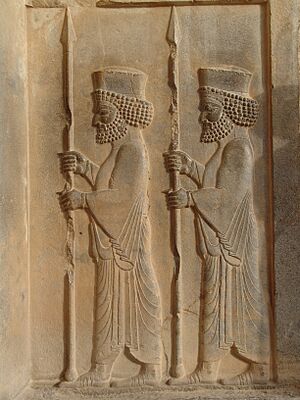
In the early 1st millennium BC, ancient Persians settled in the western part of the Iranian Plateau. They interacted with the Elamites and Babylonians. The Medes also met the Assyrians. The languages of the Medes and Old Persian show they came from the same Proto-Iranian roots.
After the Achaemenid Empire was formed, the Persian language spread. Modern dialects of Persian spoken in Iran, Afghanistan (called Dari), and Central Asia (called Tajiki) come from Old Persian.
At first, Western Iranian peoples were ruled by Assyrian empires. But an alliance of Medes, Persians, and others captured Nineveh in 612 BC. This led to the fall of the Neo-Assyrian Empire. The Medes then formed their own kingdom, stretching from northeastern Iran to Anatolia.
Later, in 550 BC, Cyrus the Great overthrew the Medes. He conquered other kingdoms and established the Achaemenid Empire (the First Persian Empire). This empire became the largest in ancient history. It covered parts of Europe, Africa, and Asia. The Achaemenids ruled for centuries. They were known for their strong government, postal system, and roads. They also freed slaves, including the Jewish exiles in Babylon.
The Achaemenid Empire fought against the Greek city-states in the Greco-Persian Wars. These wars shaped the history of Greece and Europe. Later, Alexander the Great conquered the Persian Empire, ending the Achaemenid rule.
The early people of the Achaemenid Empire likely followed Zoroastrianism. This was an ancient Iranian religion.
Eastern Iranian Peoples

While Western Iranian tribes are known through their writings, Eastern Iranian tribes are known through mentions by Greeks, Persians, Chinese, and through archaeology. The Greek writer Herodotus (5th century BC) described the nomadic Scythians. They lived in what is now southern European Russia and Ukraine.
Later, the Scythians were conquered by their eastern relatives, the Sarmatians. Strabo mentioned the Sarmatians as the main tribe controlling the southern Russian steppe around 1 AD. The Romans also knew the Sarmatians. They even sent Sarmatian soldiers to Roman Britain. These Iranian-speaking Scythians and Sarmatians ruled large parts of Eastern Europe for about 1,000 years. Eventually, they mixed with and were absorbed by the early Slavic people.
The Sarmatians were different from the Scythians. They honored the god of fire more than the god of nature. Women also played an important role in their warfare. This might have inspired the stories of the Amazons. At their largest, around 1 AD, these tribes lived from the Vistula River to the Danube and eastward to the Volga. Their land was called Sarmatia by Greek and Roman writers.
Over time, the Sarmatians in Ukraine and Southern Russia slowly disappeared. They were absorbed by Germanic Goths and later by Proto-Slavic peoples. Many place names in Eastern Europe, like the rivers Dniestr and Dniepr, come from East Iranian languages. Also, some early Slavic words, like *bogъ (god) and *divъ (demon), came from Scythian.
The Sarmatians in the east became the Alans. They traveled widely, with some even reaching Western Europe and North Africa. Modern Ossetians are believed to be direct descendants of the Alans. Their language is a Northeast Iranian language.
Some Saka-Scythian tribes in Central Asia moved southeast. They invaded the Iranian Plateau, parts of Afghanistan, and Pakistan (forming the Indo-Scythians). Other Iranian tribes, like the Khwarazmians and Sogdians, were absorbed or moved by the arrival of Turkic tribes from China and Siberia.
Today, the Sarikoli people in southern Xinjiang and the Ossetians in the Caucasus are remnants of these ancient Scythian tribes. Other Iranian peoples like the Talysh and Tats still live in the Caucasus. A small group of Sogdian descendants, the Yaghnobi people, live in Tajikistan.
Later Developments
Between the 6th and 10th centuries, Turkic peoples spread across most of Central Asia. They slowly replaced and mixed with the Iranian-speaking people there. This changed Central Asia from being mostly Iranian to mostly Turkic.
Starting around 634 AD, Muslim Arabs began to conquer the Iranian Plateau. They conquered the Sassanid Empire of the Persians. Many Iranian peoples, including Persians, Pashtuns, Kurds, and Balochis, became Muslims. The Alans became Christians, which is why modern Ossetians are Christian. Over time, Persians adopted the Shi'a branch of Islam.
Later, in the 2nd millennium AD, Iranian peoples played a big role in Islamic empires. Saladin, a famous leader against the Crusaders, was a Kurd. Empires based in Iran, like the Safavids, made a modern form of Persian the official language. Iranian culture also greatly influenced the Ottoman Empire and the Mughal Empire.
After Arab rule declined, major Iranian peoples started using their Iranian languages again. But they did not form modern national identities until the 19th and early 20th centuries.
Where Iranian Peoples Live Today
There are an estimated 150 to 200 million people who speak Iranian languages. The six largest groups are Persians, Lurs, Kurds, Tajiks, Baloch, and Pashtuns. These groups make up about 90% of all Iranian language speakers.
Most of these Iranian peoples live in Iran, Afghanistan, the Caucasus region (like Ossetia and Azerbaijan), Iraqi Kurdistan and other Kurdish areas in Turkey, Iran and Syria, Tajikistan, Pakistan, and Uzbekistan. There are also Iranian peoples in Eastern Arabia, such as northern Oman, Bahrain, and Kuwait.
Due to recent movements, many Iranian language speakers also live in Europe and the Americas.
| Ethnicity | Region | Population (millions) |
|---|---|---|
| Persian-speaking peoples | Iran, Afghanistan, Tajikistan, the Caucasus, Uzbekistan, Bahrain, Kuwait, Iraq | 72–85 |
Pashtuns
|
Afghanistan, Pakistan | 63 |
| Kurds; Zaza, Yazidis, Shabaks | Iran, Iraq, Turkey, Syria, Armenia, Azerbaijan | 30–40 |
| Baluchs | Pakistan, Iran, Oman, Afghanistan, Turkmenistan, UAE, Bahrain | 20–22 |
| Gilakis, Mazanderanis
And Semnani people |
Iran | 5–10 |
| Lurs | Iran, Kuwait, Oman and Bahrain | 6 |
Pamiris
|
Tajikistan, Afghanistan, China (Xinjiang), Pakistan | 0.9 |
Talysh
|
Azerbaijan, Iran | 1.5 |
Ossetians
|
Georgia (South Ossetia), Russia (North Ossetia), Hungary |
0.7 |
| Yaghnobi | Uzbekistan and Tajikistan (Zerafshan region) | 0.025 |
| Kumzari | Oman (Musandam) | 0.021 |
Zoroastrian groups in South Asia
|
India, Pakistan | 0.075 |
Culture of Iranian Peoples
Iranian culture is mainly found in the Iranian Plateau. Its roots go back to the Andronovo culture of the late Bronze Age. This culture was connected to other groups on the Eurasian Steppe. Over time, Iranian culture developed its own unique features.
Like other Indo-Europeans, early Iranians performed special sacrifices. They had a social structure with warriors, priests, and farmers. They also told stories through poems and sagas. Many Iranian peoples share common traditions. For example, Nowruz, an ancient Iranian New Year festival, is still celebrated by almost all Iranian groups. However, because they adapted to different environments, Iranian peoples have some differences in their dialects and customs.
Iranian peoples have made many achievements in art, science, architecture, and philosophy. Their kingdoms and empires connected much of the ancient world. They often interacted with people from both western and eastern parts of the world.
Religion
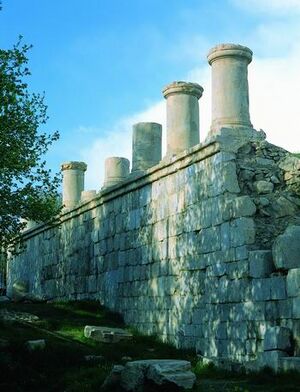
Early Iranian peoples practiced an ancient Iranian religion. This religion, like others from Indo-European groups, had many gods and goddesses. Fire was seen as very important and sacred. It was kept carefully in fire temples. They celebrated many annual festivals, often linked to farming. The most important was the New Year (Nowruz).
Zoroastrianism, a form of the ancient Iranian religion, developed later. It spread to many Iranian peoples on the Iranian Plateau. Other religions that started in the Iranian world include Mithraism and Manichaeism. Some experts believe these Iranian religions influenced early Christianity and Judaism.
Today, most Iranian people follow Islam (either Sunni or Shia). Smaller groups follow Christianity, Judaism, and Zoroastrianism.
Cultural Mixing
Iranian languages were spoken in a large area, including regions around the Black Sea, the Caucasus, Central Asia, and parts of China. Over time, some of these groups were absorbed by smaller but powerful Turkic-speaking groups. Other settled populations adopted the Persian language. This language shift was often due to new ruling groups.
Many Turkic-speaking groups on the Iranian Plateau also speak an Iranian language. They often share Iranian culture. Some Iranian peoples also mixed with the Slavs, and many became Slavic.
Some groups today are partly descended from Iranian peoples or are sometimes seen as their descendants:
- Turkic-speakers:
- Azerbaijanis: Even though they speak a Turkic language, they are believed to be mostly descended from earlier Iranian-speakers in their region. They might be related to the ancient Medes.
- Turkmens: Genetic studies show Turkmens have local Iranian DNA.
- Uzbeks: Their language and culture show older Iranian roots. Genetic studies suggest Uzbeks have a mix of Iranian and Mongol ancestry.
- Uyghurs: Modern Uyghurs are thought to be descendants of ancient Uyghurs and Iranian Saka tribes who lived in the Tarim Basin.
- Persian-speakers:
- The Hazaras are a Persian-speaking group in Afghanistan. Genetic studies show they have some Mongol ancestry, mixed with local Iranian and Turkic people.
- Slavic-speakers:
- Croats and Serbs: Some experts suggest these Slavic-speaking groups are descended from the ancient Sarmatians. The Sarmatians were an Iranian people who lived in Eastern Europe.
- Swahili-speakers:
- Shirazis: This group on the Swahili coast of East Africa has local stories that they came from merchant princes from Shiraz in Iran.
- Indo-Aryan speakers:
- Sindhis: Many Balochis, an Iranian people, moved to Sindh (in Pakistan) and mixed with the local population.
Genetics of Iranian Peoples
Recent studies show that the genetic makeup of Iranian peoples formed about 5,000 years ago. It has stayed very similar since then, meaning they were not greatly changed by migrations from outside groups. Genetically, Iranian peoples are close to European and other Middle Eastern peoples.
Studies of Iranian Persians, Kurds, Azeris, Lurs, Mazanderanis, Gilaks, and Arabs show they are very similar genetically. They form a group called the Central Iranian Cluster (CIC). Compared to people worldwide, Iranians (CIC) are in the middle of the wider West-Eurasian group. They are close to Europeans, Middle Easterners, and South-Central Asians.
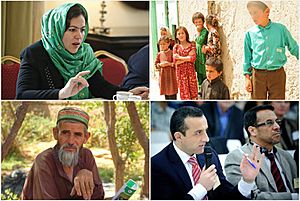

Paternal DNA Groups
Studies of Y chromosome haplogroups (paternal DNA groups) in Iran found these common groups:
- J2-M172: This is the most common paternal group in Iran (around 23%). It is also common in northern Arabs, Mediterranean, and Balkan peoples.
- R1a-M198: This group is common in Iran, especially in the east and south. This suggests a migration towards India and then a spread westward across Iran.
- R1b – M269: This group is found from Ireland to Iran. It is common in highland West Asian groups like Armenians and Turks.
- Haplogroup G: This group is most common in the Caucasus region. It is found in about 10% of Iranians.
- Haplogroup E: This group is found in less than 10% of Iranians.
Studies in Afghanistan, where several Iranian-speaking groups live, found that:
- R1a was the main haplogroup, especially among Pashtuns, Baloch, and Tajiks.
- C3 (an "East-Eurasian" group) was present, especially in Hazaras (33–40%). This is partly linked to Mongol expansions.
- J2 was present, similar to Iran (5–20%).
A 2012 study looked at 15 different ethnic groups in Iran. It found that Iranian groups have a lot of different haplogroups. This suggests that the Iranian gene pool has been an important source for DNA diversity in the Middle East and Eurasia.
A 2024 study found that ancient and modern people on the Iranian plateau have a similar genetic component to an ancient West Eurasian group. They also show some ancestry from other groups through contact events starting in the Stone Age.
Images for kids
-
The Behistun Inscription of Darius the Great describes itself to have been composed in Arya [language or script].
-
Early Indo-European migrations from the Pontic steppes and across Central Asia.
-
The Eastern Iranic and Balto-Slavic language areas in Eastern Europe.
-
Archaeological cultures around 750 BC at the start of Eastern-Central Europe's Iron Age.
See also
 In Spanish: Pueblos iranios para niños
In Spanish: Pueblos iranios para niños


